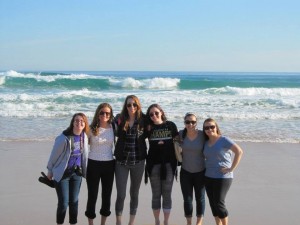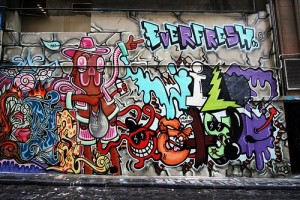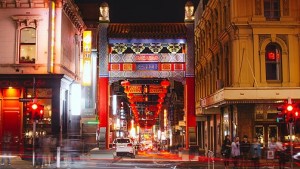Week 2 Wrap Up
After wrapping up week one in the rainy city, we got lucky with a few days of sunshine to round the corner into week two. We spent that time soaking up the sun in the great outdoors of Victoria. First, we explored the riverbeds and grassy fields of Darebin Park, a spiritual healing nature reserve. Next stop was St. Kilda Beach, home of a Luna Park and gorgeous sunsets on St. Kilda Pier.  Then finally, we wrapped it all up with our nature tour with guide Peter, aka Outback Billy. We marched all around Phillip’s Island doing everything from taking selfies with kangaroos and wallabies to watching the fairy penguins waddle across the beach to return to their burrows. However, all good weather must come to an end. When we returned to the city for our next agency visits, so did the rain…
Then finally, we wrapped it all up with our nature tour with guide Peter, aka Outback Billy. We marched all around Phillip’s Island doing everything from taking selfies with kangaroos and wallabies to watching the fairy penguins waddle across the beach to return to their burrows. However, all good weather must come to an end. When we returned to the city for our next agency visits, so did the rain…
Our next set of visits started with the Lighthouse Foundation on May 20th . This organization is dedicated to ending youth homelessness. The dedicated staff at this agency help young people who need a home and a purpose to find their place in the community. By using a therapeutic family model and trained caregivers, Lighthouse Foundation helps young people break the cycle of homelessness with an 88% success rate.
On May 21st we visited the Young and Well Center. This research institution partners with 75+ other organizations to promote the health and wellbeing of young people by creating easily accessible tools, apps, and other programs on the internet. They also seek to promote children’s rights online in this digital age. The goal of these online programs is to try to reach the 70% of young people who may be in need of help, but are not actively seeking it for various reasons. They are early intervention programs created to intervene before a young person reaches a crisis point. What is unique about this organization is that they highly value youth participation in the designing of these programs. Staff members see the young people as actual partners in this process. The adolescents that are accepted through the application process become part of what this agency calls the “Youth Brain Trust”. Youth members can participate on this panel for 1 year. Part of the goal here is to build group cohesion and a culture of peer support through this active participation in planning.
Cultural Observations
Now that we have had two weeks to soak in the city Melbourne, we have noticed many more things about the culture here. Similar to what we discovered in Where Are The Roo’s? – Week 1 Observations, the stereotypes of Australia are an inaccurate depiction of the buzzing urban areas, like Melbourne. Unlike the pictures we had painted in our heads of tan people, deserts, jeeps and kangaroos, Australia’s cities are not so different from those of the United States and other cities around the world.
-Melbourne’s City Layout
One of Melbourne’s many distinguished traits is the urban art. Graffiti is all over the city. Though there are gang names here and there, for the most part the city is covered in art. You can find one of the most well-known, and legal, graffiti spaces on Hosier Lane in down town Melbourne. Providing a space for graffiti artists to outlet and recycle their work is a tactic many cities use to decrease vandalization elsewhere. This concept is not uncommon to the United States. Austin, Texas practices this same method in their space called Baylor Street Art. Venice Beach in California also has a space for legal graffiti.
Providing a space for graffiti artists to outlet and recycle their work is a tactic many cities use to decrease vandalization elsewhere. This concept is not uncommon to the United States. Austin, Texas practices this same method in their space called Baylor Street Art. Venice Beach in California also has a space for legal graffiti.
From what we have seen, Victoria also has very similar national parks, comparable to those in the US. However, this is only one small portion of Australia. There is still this whole other side of the country that is uninhabited by humans and covered with some of the deadliest creatures in the world. There are small towns where it rains spiders and coasts with paralyzing jellyfish. So yes, in the city of Melbourne where we are doing our studies, there are some physical traits that is similar to the U.S. But in reality, the physical traits of this land are so diverse and so large, its like comparing apples and crocodiles.
-Australia’s People
When we first arrived in Melbourne, we spent some time learning about the first inhabitants of Australia – the Aboriginals. Over the past couple of weeks, we have observed that Melbourne is now home to people from all over the world. On our trip with Outback Billy we learned more facts about the increasing diversity in Australia. It is estimated that over 1 in 4 of Australia’s 24 million people were born overseas. In the last six years, the Chinese population has increased by 60%, while the Indian population has increased 100%! Australia is also the third largest country for the number of people who speak Greek (including Greece).
Similar to the U.S., many immigrants come into Australia and end up living and working in rural areas on the farms surrounding the larger cities. For example, there are many Chinese, Indian, and Vietnamese people working the farms on the outskirts of Melbourne. Within Melbourne, many different countries and cultures are represented. We have walked through Chinatown, Little Italy, and Little Vietnam. We have also seen many Greek and Indian restaurants throughout the city. Outback Billy gave us some facts on recent trends in regards to religion in Australia as well. About 50% of Australians identify as Christian, however less than 5% go to church more than twice a year. The average church population is over 60. Outback Billy pointed out a few churches for sale along our drive out in the more rural parts outside of Melbourne. We even saw a church that had been converted into a Mexican restaurant. This says a lot about how Australia’s religious trends have changed, and continue to change, over recent years.
-Chloe and Kathryn
